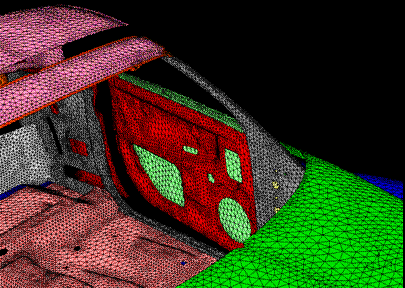 The Shell Meshing Parameters control the various surface meshing algorithms. These parameters also control the surface mesh that is used for various volume meshers.
The Shell Meshing Parameters control the various surface meshing algorithms. These parameters also control the surface mesh that is used for various volume meshers.
- Mesh type
specifies the type of surface mesh. If an individual surface is assigned a different type of surface mesh, then the local control will override the global setting.
- All Tri
meshes the geometry with a pure triangular mesh.
- Quad w/one Tri
allows for a Quad Dominant mesh with one tri element per surface. The tri element allows for better transition between uneven mesh distribution on the loop edges. Automatic tri-reduction steps may even remove the tri element.
- Quad Dominant
creates a quad mesh that allows for several transitional triangles. This mesh type is very useful in meshing complicated surfaces where a pure quad mesh may have poor quality.
- All Quad
meshes the geometry with a pure quadrilateral surface mesh.
Note: This mesh type requires uniform sizes otherwise it will create some tri elements to maintain connectivity.
- Mesh method
specifies the meshing method or algorithm to be used. If an individual surface is assigned a different type of mesh method, then the local control will override the global setting.
- Autoblock
This method uses the mapped or block-based meshing algorithm. It automatically determines the best fit to obtain the defined minimum edge and orthogonality. For surface patches that cannot be mapped (having more or less than 4 corners), the Patch Dependent method is called through this block-based algorithm.
- Patch Dependent
This is a free surface mesh generator that meshes closed regions called loops. Loops are created from surfaces or curves, and holes and internal curves are taken into account. The mesh is seeded according to the node spacing defined on the curves. Mesh from adjacent loops sharing a single curve is automatically joined together. This meshing method gives the best quad dominant quality while capturing surface details.
Note: For Patch Dependent meshing using Mesh Type of All Tri, the Curve Mesh Setup parameters of Height, Height Ratio, and Num Layers are respected, but quad elements will be used for the offset layers.
If only Height Ratio is used in conjunction with the Global Shell Meshing Parameter Adapt Mesh interior, it can control the rate of transition for the All Tri or Quad Dominant mesh types.
- Patch Independent
Patch independent meshing is best for low quality geometry or surfaces with poor connectivity. It uses the Octree method to create a robust patch independent surface mesh. See The Octree Mesh Method in the Ansys ICEM CFD User's Manual.
The geometry does not need to be a closed volume. If the Mesh Type is set to Quad mesh, the Patch Independent mesher will first generate a tri mesh, which can be automatically converted to a pure quad or quad dominant mesh.
Note: Patch independent meshing does not respect surface meshing parameters that have been set. However, it can take advantage of Octree parameters such as Curvature/Proximity Based Refinement, and Density Regions. Refer to the Table of Meshing Parameters.
- Shrinkwrap
Shrinkwrap meshing is best for geometry with gaps in STL representation. It uses the Cartesian method to initially generate all Quad mesh, with Quad dominant / All Tri options for better capturing of features. This generates watertight shell mesh with feature suppression. If the capture of greater detail is desired, then the Patch Independent Octree Tetra mesh would produce a better result, given that the model is of sufficient quality.
Note: The shrinkwrap mesher requires a closed volume input.




